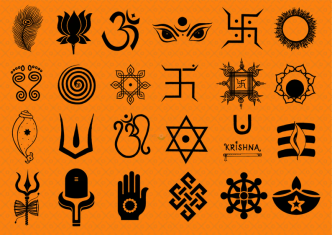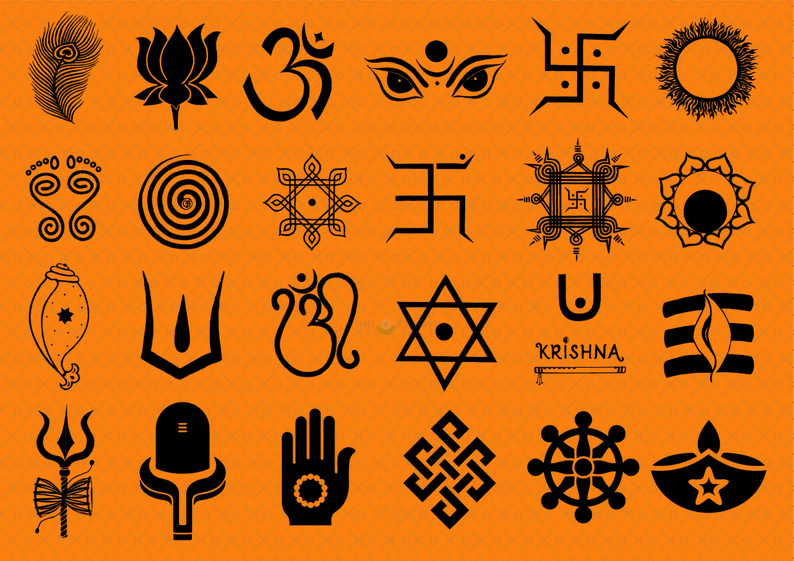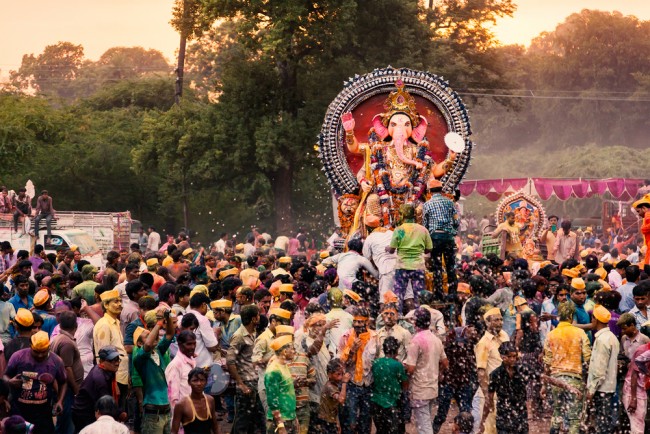Hinduism, often referred to as a “way of life,” is not merely a religion but a profound philosophy that encompasses various beliefs, practices, and symbols that hold deep spiritual significance. These symbols are not just artistic representations; they convey deep philosophical teachings, embodying the principles of creation, preservation, destruction, and the ultimate realization of the self. In this article, we explore some of the most important symbols in Hinduism, each of which carries a unique meaning rooted in ancient scriptures and teachings.
1. Om – The Sacred Sound
The symbol “Om” (also spelled “Aum”) is the most profound and universally recognized symbol in Hinduism. It is considered the sound of the universe itself, representing the essence of creation. In Vedic philosophy, Om is seen as the primordial sound, the very vibration that existed before the creation of the universe. It is said to encapsulate the entire cosmos, transcending time and space. In spiritual terms, Om is a manifestation of Brahman—the ultimate reality or consciousness.
As the sacred syllable, Om is the foundation of all Vedic mantras. It symbolizes the entire spiritual journey, from the individual self (Atman) to the ultimate reality (Brahman). Chanting Om is believed to bring a person closer to this realization, aligning the mind with the universe’s supreme frequency.
2. Swastika – Symbol of Good Fortune
Contrary to some misconceptions, the swastika in Hinduism is a symbol of auspiciousness, peace, and good fortune. The word “Swastika” comes from the Sanskrit root “su” (good) and “asti” (being or existence), translating to “that which is good” or “of good fortune.” It represents the motion of the Sun across the sky, a symbol of cyclical time, growth, and positive energy.
In Hindu tradition, the swastika is used during religious rituals and celebrations to bring blessings, prosperity, and protection. It is also associated with Lord Ganesha, the remover of obstacles, and often appears on temples, homes, and altars.
3. Trishula – The Divine Trident
The Trishula, or trident, is another key symbol in Hinduism, most commonly associated with Lord Shiva, one of the principal deities of the religion. The trident represents Shiva’s three essential aspects: the Creator (Brahma), the Preserver (Vishnu), and the Destroyer (Shiva). It symbolizes the cosmic functions of creation, preservation, and destruction, which are essential for the cycle of life.
On a deeper level, the trishula also represents the threefold nature of the universe—creation, sustenance, and dissolution. Additionally, it symbolizes the three main energies or “Shaktis” that govern the universe: will, action, and wisdom. It also correlates with the three nadis or energy channels (Ida, Pingala, and Sushumna) that guide the flow of Kundalini energy through the chakras.
4. Yantra – Sacred Geometrical Designs
A Yantra is a mystical and geometrical diagram used in Hindu rituals and meditation. These patterns are composed of various shapes like squares, circles, and triangles, and are designed to channel spiritual energy. The central point of a yantra represents unity and the origin of all creation, reflecting the concept of manifestation and emanation.
The Sri Yantra, also known as the Sri Chakra, is considered the mother of all yantras. It is said to symbolize the cosmic mountain Mount Meru, believed to be the center of the universe. The Sri Yantra is widely regarded as a powerful tool for meditation, thought to bring spiritual blessings and inner peace to the practitioner.
5. Lamp – Symbol of Light and Knowledge
The lamp holds profound symbolic meaning in Hinduism, representing knowledge, wisdom, and the dispelling of darkness. Fire, as an element, has played a significant role in human development and is revered as a source of light and energy. The lamp, which is a miniature version of fire, thus symbolizes the divine light that removes ignorance and enlightens the soul.
Lighting a lamp, especially during religious ceremonies, is considered an act of spiritual purification. It signifies the triumph of light over darkness, good over evil, and knowledge over ignorance.
6. Shankha – The Conch Shell
The Shankha (conch shell) is a powerful and ancient symbol in Hinduism, often used during religious rituals and as an instrument of prayer. The conch represents the primordial sound of creation, and its blow is believed to call the devotees to prayer and drive away negative energy and evil spirits.
The conch also symbolizes the voice of God, as it is believed that the sound produced by blowing the conch resembles the sacred vibration of Om. It is a common practice to blow the conch at the beginning of pujas or religious ceremonies to purify the space and invoke divine blessings.
7. Kalash – Symbol of Creation
The Kalash, or sacred pot, is a symbol of prosperity, fertility, and the creation of life. It is often filled with water, which represents the primordial waters from which life emerged. The Kalash is decorated with mango leaves and a coconut placed on top, symbolizing creation and the nourishment of life.
The Kalash is a key element in many Hindu rituals, signifying the creation of the universe and the divine essence that sustains it. The water-filled pot represents the infinite and the divine flow of life, while the coconut symbolizes the body, and the leaves signify the relationship between the physical and spiritual worlds.
8. Tilak – Mark of Auspiciousness
A Tilak is a mark applied to the forehead, signifying auspiciousness and blessings. It is usually made with materials such as sandalwood paste, sacred ash (bhasma), or kumkum (a red turmeric powder). Different communities and deities have their specific tilaks: devotees of Lord Shiva often use sacred ash, while followers of Vishnu apply sandalwood paste, and worshippers of the Goddess (Devi) use kumkum.
The tilak is not only a mark of identity but also serves as a spiritual symbol, representing the divine eye and reminding the wearer to focus on the higher self and spiritual consciousness.
9. Namaskar – The Gesture of Reverence
“Namaskar” is a traditional greeting mentioned in the Vedas, where one folds their hands and bows their head in respect. It is a gesture that acknowledges the divine presence in others, expressing humility and reverence. While commonly understood as prostration, Namaskar is more than just a greeting; it is an act of paying homage, an acknowledgment of the sacred in each individual.
Chanting mantras is an integral part of Hindu rituals. These sacred verses, passed down through generations, are believed to have divine power. Mantras carry vibration and sound that aid in invoking the presence of the deities, purifying the mind, and strengthening the connection to the spiritual realm.
10. The Richness of Hindu Symbolism
Hinduism, being one of the oldest religions in the world, boasts a vast array of symbols, each with a unique meaning and purpose. The symbols mentioned above are only a few of the countless emblems that have deep spiritual connotations. These sacred symbols are not only part of religious rituals but are also embedded in everyday life, shaping the thoughts, actions, and spiritual journeys of millions of Hindus around the world.
Each symbol reflects the interconnectedness of the universe, the balance of opposites, and the constant flow of life energy. Understanding these symbols can provide a greater insight into Hindu philosophy and the profound spirituality that guides it.
Conclusion
In Hinduism, symbols are much more than decorative elements; they are living expressions of deep spiritual truths. They represent not just the physical aspects of life but also the cosmic, metaphysical forces that govern existence. Through these sacred symbols, devotees connect with the divine, seek inner peace, and navigate the journey of self-realization. Whether through the sound of Om, the geometry of the yantra, or the reverence shown through Namaskar, each symbol carries a profound significance that transcends the material world and leads the individual toward spiritual enlightenment.
Disclaimer: The opinions expressed in this article are those of the author. They do not claim to represent the opinions or perspectives of Indography.
Author: Poonam Rajput (x.com: @silent0025_)











